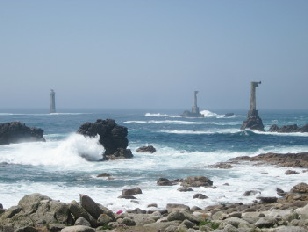The island of Ouessant is one of the most remarkable places in Brittany.
This extract is from a much longer text.
The island of Ouessant - extract from Brittany: a cultural history (2014)
The island itself has a history of austerity for man and a richness of nature surprising in such a treeless and weather-swept landscape. At 8 x 3.5 km and 1550 hectares it is a sizeable terrain, split along an east-west fault-line, now a lush green valley of low trees and reservoirs. There’s no shortage of fresh-water sources, as stone lavoirs in the scattered hamlets show. Traditionally the houses are white-washed with blue shutters, the archetypal colours of the island. No garish constructions by wealthy incomers spoil the profound simplicity of a vernacular architecture dictated by the demands of the weather.
In no sense is Ouessant dull. The bourg of Lampaul is rife with flowers, pink and white valerian exploding like fireworks from the high stone walls, every garden planted to burst out in brightness as early as the seasons allow. On the swathes of pasture and cliff-top landes, a coloured quilt of wild flowers has replaced the traditional patchwork of tiny walled plots of land which once covered the island, the women’s domain of production. Nearly gone too are the numerous tiny windmills, wooden huts on a round granite base, which ground each family’s corn. Star-shaped sheep shelters remain here and there, designed to offer relief from the multi-directional blasts of wind. On the springy surface of the moors, are gorse – in places deliberately cultivated within walls for fuel and fodder – heather and yellow flowers of fresh broom which pop up despite the wind ordering their flattened foliage to stay low. Clumps of thrift, blue freckles of scilla, pink scabious, wild thyme and honey-suckle vivify the grassy plains.
The sea has always rolled out the imaginative and everyday rhythm of this place. Local legends feature the Morganez and Morganezed, mer-people who live in the ocean and sport on the shore, enjoying unpredictable contact with humans like arrogantly beautiful Mona Kerbili who was snatched away to an underwater kingdom. Reality, however, is about life at the behest of the elements and striking a balance between the demands of land and sea. Ouessant itself is the strong, solid hub at the centre of turbulence, ringed by lighthouses protective of mariners and islanders alike. Watching the entrance to the bay of Lampaul is the Phare de la Jument, and Kéréon, named for a young victim of the Revolution, stands sentinel over the Fromveur. On the north-eastern and highest point at 60m is Le Stiff, the oldest still working example in France, ordered by Vauban in 1695 and now looking like a functional pimple beside the elegant grace of the 75m radar tower built in 1982.
The ragged edge of the north coast from Le Stiff to the Pointe de Pern has borne the brunt of the weather and tides, raw rock faces like eviscerated innards of the earth, the granite slowly disintegrating via fissures where the insidious moisture of the salt air has penetrated. Fantastic formations contribute to the sense of rough brute creation, a work hewn of gigantic movements over aeons of time, a work in progress if the elements have their brutal way, shearing off any tell-tale friability. Looking seaward beyond the Ile de Keller with the eerie outline of its single house, there is only ocean, often merging into a misty, muzzy soft blue-grey of sky.

